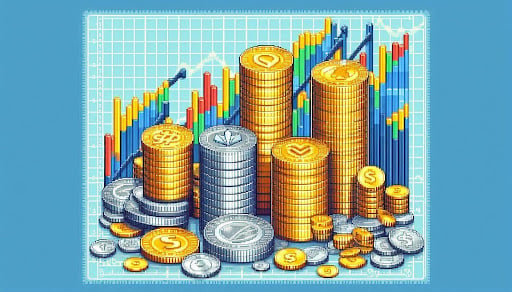
Image Source: Microsoft Copilot
Timing is everything in the world of investing, and this is relevant for portfolio diversification above all else, because you don’t want to buy into an asset class as a means of reducing risk and staying clear of volatility, only to find that you made a misstep.
This is where pivoting our discussion to gold and silver comes into play, as there’s consistent evidence to show that these precious metals have been, are now, and will continue to be a solid place to put your money.
So if your portfolio is currently bereft of these elements, stick around to find out why this needs to change, and soon.
The Stability of Gold and Silver in Economic Downturns
Gold and silver have long been a means of preserving wealth, particularly during times when the wider economic outlook is grim, or there’s simply a prevailing uncertainty about what the future holds.
Here’s the evidence to support this diversification strategy:
Consistent Value Retention
Precious metals haven’t just been a value store for a few decades – they’ve been coveted, collected and traded for millennia. More recently, this has played out in a couple of ways:
- During the 2008 financial crisis, while stock markets plummeted globally, gold saw a significant upsurge – rising 50% in just eight months. By 2011, it had reached an all-time high of $1,855 per ounce, and while it would retreat down slightly over the coming years, it has so far stayed well above pre-credit crunch levels.
- In the tumultuous market conditions of 2020 triggered by the global pandemic, gold breached the $2,000 mark for the first time in history, underscoring its role as a stabilizer. Since then it has maintained this momentum, passing $2,240 in April 2024.
Resilience Against Inflation
The entire planet has been staring down the barrel of steep inflation over the past couple of years, compounded by rising living costs that mean even affluent households are feeling the pinch. Gold and silver investments can be the antidote to inflation’s ability to erode the value of savings and investments.
The data once again supports this claim – with a study spanning 35 years showing that whenever inflation peaks, precious metal prices are bolstered by an impressive 14.9% on average.
Diversification Benefits
Typically, gold and silver exhibit a low correlation with stocks and bonds. For instance, during periods of high market stress between 1987 and today, these metals showed a correlation factor close to -0.10 with U.S. equities.
This is one of the main reasons that stacking gold and silver is sensible – so long as you go about it in a strategic way. This pivot in your portfolio needs to be made based on information and your investment goals, so do your research and get advice from a financial advisor to ensure any moves you make are the right ones.
Practical Steps to Acquiring Precious Metals
Once you’ve decided to diversify your portfolio with gold and silver, the next step is understanding how to effectively acquire these assets. Here are a few considerations:
Choosing the Right Form
Precious metals come in various forms, and your main choice here is between physical ownership and intangible investment. These are:
- Bullion Coins or Bars: As the most direct form of owning physical gold and silver, there are several popular choices including American Eagles, Canadian Maple Leafs, and South African Krugerrands for gold; and American Silver Eagles and Canadian Silver Maple Leafs for silver.
- Gold and Silver ETFs: Exchange-traded funds (ETFs) offer a way to invest in gold and silver without physically holding the metals. Examples include SPDR Gold Shares (GLD) or iShares Silver Trust (SLV).
Where to Buy
It should go without saying, but if you’re investing in physical gold or silver as an asset, always purchase from reputable dealers who provide authenticated products. The U.S. Mint’s website lists authorized dealers.
Also, since prices can vary significantly between dealers, it’s wise to compare terms and fees as well as the asking price of particular precious metal products. This is all part of doing your due diligence as an investor.
Considerations for Storage
Suppose you’re purchasing physical metals as an investment. In that case, you need to protect them – so you can either consider setting up safe deposit boxes at a convenient bank, exploring private vault services local to you, or purchasing high-security home safes so that you’re in total control of the assets you own.
Tax Implications
Understanding tax considerations and filing returns to reflect details accurately is crucial for any investment, and is more complex than you might think where precious metals are concerned.
For instance, while selling gold and silver ETFs is covered by capital gains tax, for physical holdings these precious metals are classified as collectibles, and so face a steeper maximum tax rate of 28%.
The Bottom Line
In short, there are lots of reasons that gold and silver are the assets that people turn to when the going gets tough, economically speaking. And while having them in your portfolio even in times of prosperity makes sense, increasing your stake as a hedge against ongoing uncertainty is another recommended strategy.
Discover more from Market Business News
Subscribe to get the latest posts sent to your email.

